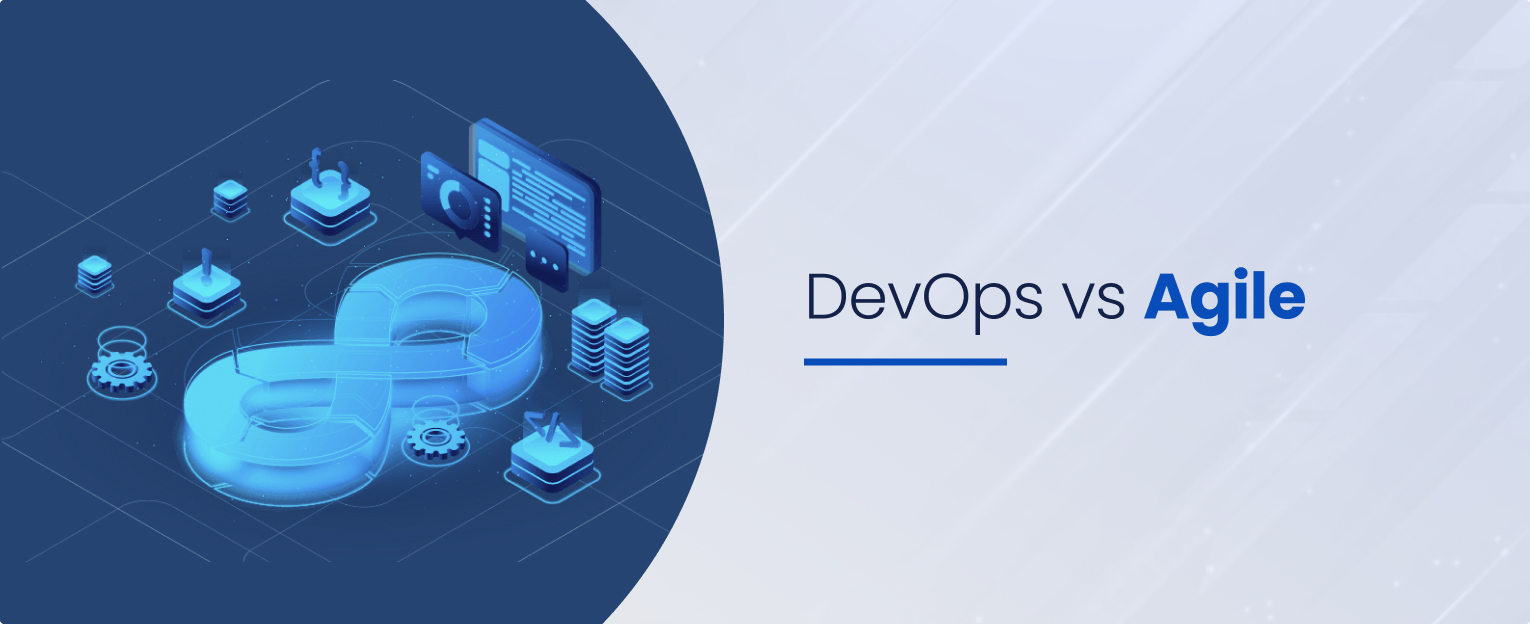DevOps and Agile methodologies have revolutionized how organizations create, deliver, and improve software. Both approaches aim to streamline development, ensure faster releases, and enhance product quality.
While Agile focuses on refining the development process, DevOps extends beyond to optimize deployment, infrastructure, and operations.
This blog will explore the comparison and synergy between DevOps and Agile, providing an in-depth understanding of their roles, key differences, similarities, and how they can complement each other.
What is Agile?
Agile is a software development methodology focused on iterative and incremental progress. It aims to deliver software that meets customer needs more efficiently by breaking development into small, manageable sprints or iterations. Agile’s guiding principles are rooted in collaboration, adaptability, and responding to changes based on customer feedback.
Agile emphasizes communication between developers, customers, and other stakeholders, which helps teams rapidly adapt to shifting requirements. The Agile Manifesto, created in 2001, introduced core principles like:
- Individuals and interactions over processes and tools
- Working software over comprehensive documentation
- Customer collaboration over contract negotiation
- Responding to change by following a plan
Agile thrives in environments where flexibility and customer satisfaction are the primary drivers of success. Working in short sprints, development teams can focus on delivering working software regularly and iteratively, allowing stakeholders to review, test, and provide feedback at each step.
What is DevOps?
DevOps is a cultural and technical movement integrating software development (Dev) and IT operations (Ops) into a cohesive process. It focuses on continuous collaboration between development and operations teams, helping them achieve faster and more reliable software delivery.
DevOps introduces automation and continuous delivery practices to streamline software development, testing, deployment, and infrastructure management.
Implementing DevOps, organizations aim to:
- Improve release cycles through automation
- Increase system reliability through continuous monitoring
- Reduce the gap between development and operations by promoting cross-functional collaboration
DevOps adopts tools like CI/CD pipelines, containerization, and cloud infrastructure to automate many traditionally manual tasks, enhancing the overall efficiency of the software development lifecycle.
Its goal is to achieve a continuous software delivery flow, ensuring operational stability alongside frequent updates.
Agile vs. DevOps: A Side-by-Side Analysis of Key Aspects
| Key Aspect | Agile | DevOps |
| Focus | Development process: building software incrementally | Deployment and operations: ensuring smooth, continuous delivery |
| Team Structure | Development teams work in iterative cycles | Cross-functional teams including developers, operations, QA |
| Delivery Approach | Iterative approach using sprints (2-4 weeks) | Continuous Integration/Continuous Delivery (CI/CD) with automation |
| Automation and Tools | Focuses on people and processes | Prioritizes automation for deployment, monitoring, infrastructure |
| Feedback Loops | Customer feedback after each sprint | Continuous feedback during development, testing, and deployment |
| End Goal | Produce high-quality software based on customer needs | Deliver stable, reliable software with operational efficiency |
| Customer-Centric Approach | Delivers software to meet customer needs | Ensures reliable, efficient delivery to the customer |
| Iterative Process | Iterative development of software | Integrates with Agile’s iteration for faster feedback and improvement |
| Collaboration | Team collaboration within the development team | Collaboration across development, operations, and other departments |
| Continuous Improvement | Focuses on feedback and adaptation after each iteration | Focuses on continuous improvement during the entire lifecycle |
Key Differences Between DevOps and Agile
While both DevOps and Agile aim to accelerate software development and improve product quality, they differ in several key areas.
Let’s explore the significant distinctions between the two:
1. Focus: Development Process vs. Deployment and Operations
- Agile: Primarily focuses on improving the development process. It revolves around building software in small increments, using short sprints to meet customer needs quickly.
- DevOps: Emphasizes software deployment, infrastructure management, and operational efficiency. It seeks to bridge the gap between development and operations, ensuring smooth and continuous delivery.

Lack of Agility Slowing Down Innovation
Empower your teams to innovate faster by implementing agile DevOps processes that keep up with market demands.
Boost agility and accelerate growth with our tailored DevOps solutions.
2. Team Structure
- Agile: Development teams work in iterative cycles, focusing on improving software incrementally.
- DevOps: Integrates cross-functional teams where developers, operations, and quality assurance collaborate throughout the software lifecycle. Many organizations leverage DevOps consulting services to implement this collaborative structure and streamline operations.
3. Delivery Approach
- Agile: Follows an iterative approach, working in short sprints (typically 2-4 weeks), with defined deliverables after each cycle.
- DevOps: Implements Continuous Integration/Continuous Delivery (CI/CD), emphasizing automation for a more frequent and consistent release process. This is one of the key DevOps best practices, ensuring rapid and reliable software delivery.
4. Automation and Tools
- Agile: Relies on people and processes to improve software development and product quality.
- DevOps: Prioritizes automation, using tools and technologies to streamline deployment, monitoring, and infrastructure management. Automation is a crucial factor in realizing DevOps benefits for business, improving productivity and reducing manual errors.
5. Feedback Loops
- Agile: This approach incorporates customer feedback after each sprint or iteration, allowing for improvements and adjustments based on user needs.
- DevOps: Operates on a continuous feedback loop, gathering insights during development, testing, and deployment stages. This constant feedback is vital for a successful DevOps transformation, ensuring continuous optimization throughout the development lifecycle.
6. End Goal
- Agile: Aims to produce high-quality software that aligns with customer needs and preferences.
- DevOps: Focuses on rapidly delivering stable and reliable software, ensuring operational efficiency alongside frequent updates.
4 Similarities Between DevOps and Agile
Despite their differences, DevOps and Agile share several common principles, making them complementary methodologies for software development.
1. Customer-Centric Approach
Both methodologies emphasize quickly delivering value to the customer. Agile focuses on delivering software that meets customer needs, while DevOps ensures that the delivery process is reliable and efficient.
2. Iterative Process
DevOps integrates seamlessly with Agile’s iterative approach, where both aim to break down large tasks into smaller, manageable increments, enabling faster feedback and improvements.
3. Collaboration
Agile encourages team collaboration within the development team. DevOps takes this further, fostering cooperation between development, operations, and other departments involved in the software lifecycle.
4. Continuous Improvement
Agile and DevOps prioritize continuous improvement through feedback loops, iteration, and adaptation. This ensures that teams constantly refine their processes and products to meet changing customer demands.
Can DevOps and Agile Work Together?
Yes, DevOps and Agile can complement each other effectively. Many organizations use both methodologies for faster, more efficient software development and delivery.
Together, they create a holistic approach to software development, where Agile helps teams quickly develop software, and DevOps ensures that this software is deployed and maintained efficiently in production.
Here’s how they work together:
- Agile provides a framework for iterative software development, focusing on customer feedback and adaptability.
- DevOps enhances Agile by introducing CI/CD pipelines, automation, and infrastructure management, ensuring that software can be deployed rapidly and reliably.
FAQs
What is the main difference between DevOps and Agile?
The main difference lies in their focus. Agile focuses on improving the software development process, while DevOps extends beyond development to enhance deployment, infrastructure, and operations.
What are the fundamental principles of Agile?
Agile is built on principles like iterative development, customer collaboration, and adaptability to change. The Agile Manifesto outlines four core values: prioritizing individuals and interactions, working software, customer collaboration, and responding to change.
Which methodology is better, DevOps or Agile?
Neither methodology is objectively “better.” It depends on the organization’s specific goals. Agile is best for managing development processes, while DevOps is ideal for streamlining deployment and operations.
Conclusion
DevOps and Agile are essential methodologies that improve software development’s speed, efficiency, and reliability. While Agile focuses on refining the development process, DevOps ensures seamless deployment and operational efficiency.
Modern businesses can benefit from both methodologies, creating a more integrated approach to software development and delivery.
With the adoption of a DevOps and Agile strategy and partnering with Folio3 Cloud services, organizations can deliver software faster, respond to customer needs more effectively, and maintain operational stability, providing a competitive edge in today’s fast-paced tech landscape.














